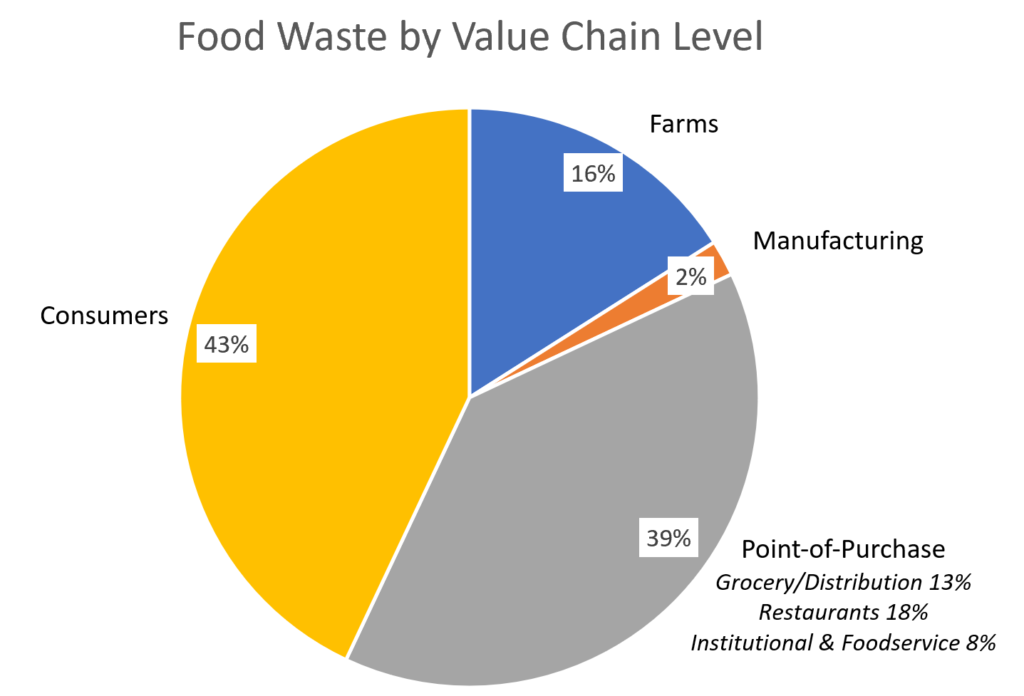By Ken Donaven, Martec Director
This is part 2 of a 3-part blog series on food waste. To read the first part, click here.
Americans waste more food than any other country in the world. This is unconscionable in a country that still struggles with food insecurity. Two questions are paramount in my mind: how could we possibly waste that much food? And, what can we do about it? Jeff Clark, Sustainability Expert at the National Restaurant Association, agrees that there is a moral component to understanding and reducing our food waste problem: “There are millions of people in the US who are food insecure. It is unacceptable that we throw perfectly good food away on a regular basis.” The problem, per Mr. Clark, is threefold:
- Food is relatively cheap for the majority of Americans and therefore inexpensive to throw in the landfill
- Landfill space is plentiful and landfill tipping fees are low in many parts of the U.S.
- Waste reduction infrastructure often is lacking
Food waste is an issue across all layers of the food & beverage value chain. However, the vast majority of this waste is generated either at the point-of-purchase (supermarkets, restaurants) or by consumers themselves.
According to the National Resources Defense Council (NRDC), the 35 million tons of food waste in the US is generated as follows:

With an understanding that 80%+ of US food waste (approximately 29 million tons…the vast majority of which ends up in landfills) occurs either at the point-of-purchase or at the household/ consumer level, the first question of “how do we waste so much food?” can be more closely examined. We’ll start with the restaurant industry, where myriad factors contribute to food waste:
Portion Sizes – Excessively large portions offer great customer value but often result in diners’ inability to finish their meal.
Menu Diversity – Large menus, with many choices for patrons, make inventory management more challenging. Infrequently used ingredients can spoil before use.
Employee Turnover – Notoriously high employee turnover within the restaurant industry means it is often expensive to train staff in nonessential practices like minimizing overproduction, separating waste for composting and detailed inventory management.
Inadequate Composting Infrastructure – There are over 3,000 landfills in the US, but fewer than 350 composting facilities that accept food waste. Further, even with access to a composting facility, restaurants frequently do not have enough back-of-house space to store food waste…resulting in landfill disposal for the waste majority of waste.
Measurement Challenges – Collecting data on food waste is a huge challenge at restaurants. Waste is difficult to measure and define, resulting in uncertainty around the impact and cost of food waste.
Thankfully, the restaurant industry, in conjunction with the National Restaurant Association, is making efforts to address the food waste problem. Clark notes: “We are piloting a waste reduction initiative within the restaurant segment. It’s a simple matter of business efficiency…business owners want to cut costs wherever they can, and food waste often is an unrealized cost that directly hits the bottom line.”
Unfortunately, some sub-segments of the restaurant industry are more challenging than others. Independently owned, full-service restaurants (especially those with expansive menus), sometimes have difficulty projecting how much food is needed, which can result in over-ordering and challenging inventory management. Further, as Clark reports, “Depending upon where a restaurant is located, some larger full-service restaurants can find it very difficult to donate leftover edible food to food banks or start a composting initiative. The lack of infrastructure for rescuing food and composting food waste really hurts these operations. In these instances, the restaurant owners and managers should focus on predictive ordering software for food deliveries and building a staff culture around using food both safely and efficiently to minimize waste and reduce costs.”
On the other hand, Mr. Clark reports quick-serve restaurants (QSRs) typically have less waste, due to the highly efficient, easier to forecast nature of their business. Further, many QSRs, such as Yum Brands and Starbucks, have programs in place to donate food that is leftover.
Beyond these initiatives, it is critical that both restaurants and state/local governments further address the food waste issue.
Portion Size and Menu Diversity – It may seem to be a simple fix…decrease portion size and/or reduce the number of menu items. However, many restaurants view these “problems” as competitive differentiators. Short of legislation mandating portion size and/or menu choices (a slippery slope), restauranteurs should voluntarily adapt their menus and operations for greater flexibility. Offering patrons smaller/half portions, daily specials (to quickly turn excess inventory), and a-la-carte options for side dishes should reduce the amount of waste generated. As a bonus, these practices should have a positive impact on operating margins.
Employee Turnover – Improved employee training, paired with incentives tied to food waste reduction
Inadequate Composting Infrastructure – This is a much bigger challenge, that may require legislative action to address. States and municipalities should act to aggressively increase the number of food waste composting facilities and address the proximity of these facilities to large urban centers with high restaurant concentration. Further, restaurants should address operational practices and kitchen design to more readily allow for food waste diversion to composting facilities.
The food waste problem in America cannot be solved without increased awareness of the issue and innovative solutions throughout the value chain. In addition, suppliers to the food & beverage industry and government bodies can help expedite the solution.
In the next edition of this blog series, I will explore the consumer side of the food waste problem and how innovative packaging and improved “best by…” dating practices can be part of the solution.




